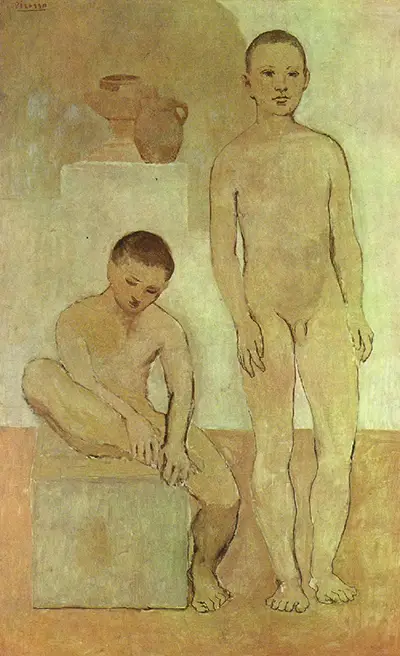The painting was produced close to the end of Picasso's so-called "Rose Period", which lasted from about 1904 to 1906 and included many other works using similar shades. Picasso had met Fernande Olilvier, the Parisian who became not only his model but his lover, in 1904. Although their relationship was often stormy, it lent a generally light and optimistic feel to his Rose Period paintings. In the early part of their time together, Picasso and Fernande paid a visit to the village of Gosol in Spanish Catalonia, high in the Pyrenees. The earth in the region was a striking shade of ochre, and this is thought to have been the primary inspiration for Picasso's use of the colour at this time.
The appearance of the young people in Teenagers is reminiscent of those in classical sculptures, with both conforming to poses often used in ancient Greek art. On the left, a young man has his arms crossed above his head, drawing attention to the strength and symmetry of his nude form, balanced by his thickly muscled legs. Next to him, facing away from the viewer, is a second adolescent. This person's sex is uncertain, as the slimmer lines of the body, especially in the legs, could be those of either a girl or a somewhat androgynous second male.
Beneath the legs of the nudes, fainter lines can be perceived. These are all that remain of a sketch for a proposed second painting on a similar theme, one with which Picasso did not proceed. The painting is sometimes described as foreshadowing the return to neoclassicist principles which Picasso and many of his contemporaries executed in the 1920s.
Teenagers measures approximately 151 cm by 94 cm. It was originally purchased by Ambroise Vollard, among the most influential of early 20th century art dealers. In 1930, he sold the painting to the noted collector Paul Guillaume; on his death in 1934, it passed to his widow Domenica. Teenagers is now held by the Musée de l'Orangerie in Paris, which specialises in Impressionist and Post-Impressionist works.

